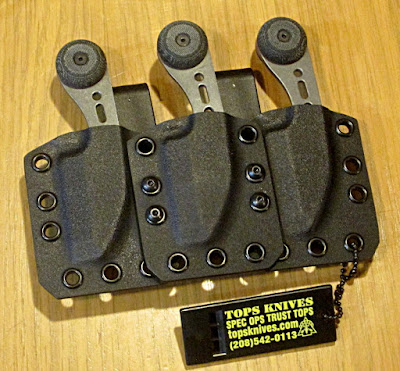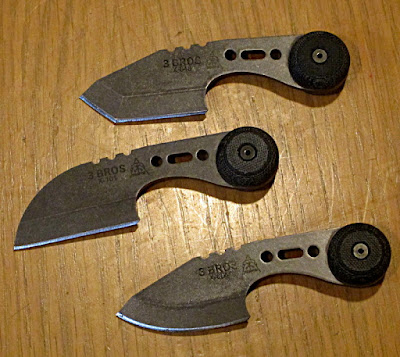Have you
noticed how things come in threes? Three
leaf clovers are common. Winning card
hands can be three of a kind, or perhaps menus give you three choices from
three different selections each containing three different dishes. Maybe you have three bourbons on the shelf?
Why not
knives? TOPS thought.
 |
| Don't forget TOPS trademark whistle! |
Face it; most
of our cutting chores are small. We need
a small utility knife, but considering the world we live in, we want max
performance. Why not put three different
blade configurations, Hunter's Point (spear point), Tanto and Sheep's Foot
blade in a small belt carry package.
Well, that’s what TOPS Knives has done.
They call it 3 Bros.
So who is
TOPS?
In 1998, TOPS
Knives was founded to create the highest-quality knives using the extensive knowledge
and real life experiences of Military Operatives, Law Enforcement Officers, and
outdoor professionals. Perhaps the best
part, all TOPS knives are manufactured and hand-finished at their facility in
the Rocky Mountains, USA.
TOPS Knives
have been requested and deployed in "Hot Spots" all over the world.
Numerous individuals who are or were Field Operators have used these knives and
report top performance and reliability when their lives depended on the tools
they had with them. That’s a pretty hard
claim to top.
The 3 Bros are
also very easy to carry everyday. Even in the sheath, one of these knives only
weighs 2.8 ounces.
Specs:
Overall Length 4.27 inches
Blade Length 2.00 inches
Cutting Edge 2.00 inches
Blade
Thickness 0.120 inches
Blade Steel 1095 steel hardened to RC 56-58
Handle
Material Black Canvas
Micarta
Knife Weight 1.9oz
You can
purchase one, two or all three. For a
little extra you can go with serrations and/or camo finish. I’d hate to break up a family, so I got all
three.
 |
| The small size was not found to be a limitation with daily chores. |
Each knife has
three deep depressions on the spine.
It’s a little aggressive for naked skin but fine for the glove hand. Each knife has a deep bolster which acts as a
finger guard to prevent hand injuries from sliding onto the blade. The edge goes just about all the way to the bolster
and there is no ricasso.
The blades are
a flat-sided saber grind ending at a shoulder about one third of the way on the
blade. This provides sufficient room to
grip the blade by thumb and forefinger while the ring and social finger grip
the Micarta disk on each side of the knife.
The disk provides a nice anchor point even if you are wearing gloves.
 |
| The small sized was not a factor wearing gloves. The micarta disk provided sufficient grip as did the massive jimping. |
TOPS blades
are made of 1095 steel and they recommend an 18-20 degree sharpening edge. These knives can be sharpened with ordinary stones
but can also be sent to TOPS for a new factory edge. The warranty card spells it out for you.
I’ve never
owned a TOPS knife that didn’t perform.
The 1095 steel will hold an edge, but will need resharpening with
use. The steel needs to be taken care of
with a protective coating of oil or corrosion inhibitor. If you anticipate needing it for food preparation
or consumption, make sure you use food safe oil. Nobody likes the trots!
You can get
yours at: https://www.topsknives.com/3-bros
A single knife
is $70, but they’ll deal you all three for $160.00.







